Superior Skateboard Decks: Quality and Performance Insights
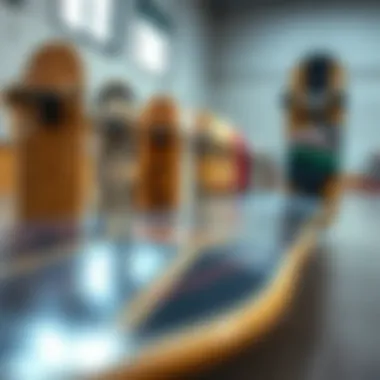
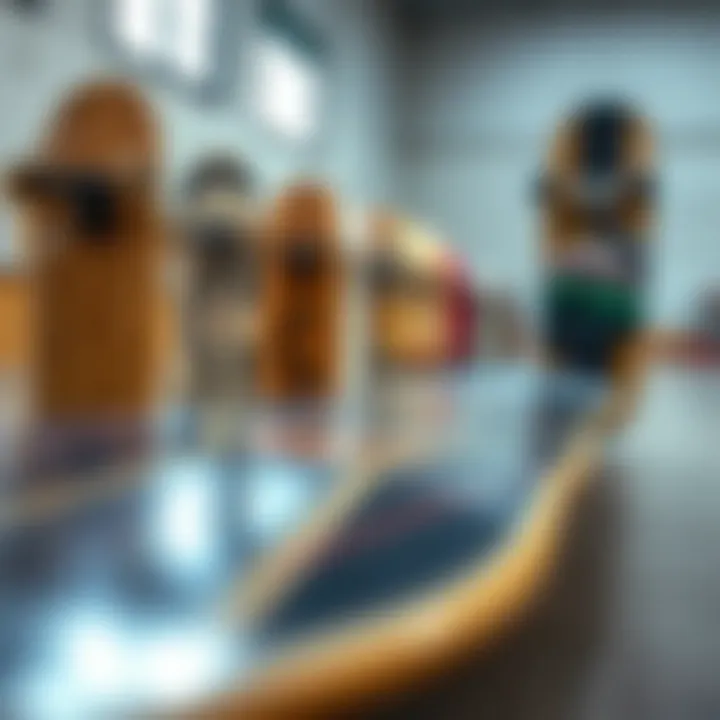
Intro
Skateboarding is more than just a sport; it’s an art form, a culture, and a lifestyle. At the heart of this culture lies the skateboard deck, an often overlooked yet critical piece of equipment. Skateboard decks come in various shapes, sizes, and materials, each influencing how a skateboarder interacts with the board and the environment around them. Understanding what makes a deck superior goes beyond the superficial; it requires a deep dive into design, construction, and personal preference. This exploration aims to unpack the various components that define quality skateboard decks and how they ultimately affect performance and rider experience.
Skateboarding Techniques
Essential Tricks for Beginners
For those just starting out, mastering basic techniques is key. These foundational tricks not only build confidence but also prepare skaters for more intricate maneuvers in the future. Here are a few essential tricks:
- Ollie: This is the building block of most skateboard tricks. A solid ollie allows riders to jump and navigate obstacles smoothly.
- Shuvit: A beginner's favorite, this trick involves rotating the board 180 degrees while keeping the body stationary.
- Kickflip: This adds a little flair; a kickflip involves flicking the board with the front foot while jumping in the air.
Understanding these basic tricks ensures a strong foundation and enhances a skater's capability to progress.
Advanced Maneuvers for Experienced Skaters
Once skaters have nailed the basics, they can start to push their limits. Advanced tricks take dedication and skill but elevate the overall experience. Here are some must-know maneuvers:
- Heelflip: Similar to the kickflip but with the heel pushing the board. It requires precision and timing.
- Boardslide: Sliding on rails or ledges with the board underneath the skater. It combines balance and technique.
- Switch Stance tricks: Learning tricks in a non-dominant stance challenges flexibility and skill, diversifying one's skate repertoire.
"Skateboarding is about progression. Mastery of the board requires patience and a willingness to fall, get up, and try again."
Gear and Equipment Reviews
Top Skateboards for Every Skill Level
When it comes to gear, the selection can be daunting. Having the right skateboard can mean the difference between an enjoyable ride and a frustrating experience. Here’s a breakdown:
- Beginners: The Element Section Complete Skateboard is a solid choice. It’s sturdy, yet lightweight, perfect for learning basics without breaking the bank.
- Intermediate Skaters: The Baker Brand Skateboard Deck offers versatility and style, with a sturdy build suitable for a range of tricks.
- Advanced: The Almost Skateboard Deck combines a unique construction materials that enhance pop and durability, making it an excellent choice for seasoned skaters.
Protective Gear: Importance and Recommendations
Skateboarding, while exhilarating, can be risky. Proper protective gear is essential for safety and confidence. Recommended gear includes:
- Helmet: A reliable helmet can prevent serious injuries. Brands like Pro-Tec have proven reliable.
- Wrist Guards: These help avoid injuries during falls, especially for beginners.
- Knee and Elbow Pads: They provide extra protection when learning new tricks, making them essential for skaters of all levels.
For further information about skateboarding safety, check out The National Skateboarding Association. To learn more about skateboard designs and history, visit Wikipedia's Skateboarding page.
Skateboarding isn’t just a hobby; it's an evolution. It shapes the road you ride on and the tricks you conquer.
Understanding Skateboard Decks
Diving into the realm of skateboard decks means peeling back the layers of what really makes a skateboard tick. This section serves as the foundation of the entire discussion, setting the stage for understanding the elements that contribute to a deck’s performance, durability, and aesthetic appeal. Skateboard decks are not just planks of wood; they are essential components that can influence not only how a board rides but also a skateboarder’s style, technique, and overall experience.
Definition and Purpose
A skateboard deck is essentially the flat surface where riders place their feet. It’s the centerpiece of the entire skateboard setup. Without it, all the wheels and trucks would essentially serve no purpose. The primary function of the deck is to provide a platform for performing tricks as well as a means to navigate various terrains. A well-designed deck allows skaters to express their personality and style through its shape and graphics.
Components of a Skateboard Deck
The construction of a skateboard deck is intricate and intentional. Let’s break down its main components that come together to create an ideal riding experience.
Wood Material
Most skateboards are made from wood, and the choice of material can play a significant role in how the deck performs. Maple wood has become the gold standard, favored for its strength and resilience. It boasts a unique characteristic of being able to take a beating while providing great pop, making it a popular choice for both street and park skating.
On the flip side, bamboo is becoming more recognized. It is lighter and often offers a different flex that appeals to some skaters. However, while it brings a smooth ride, its durability does not always match that of traditional maple. The alternative of plywood allows for lower-cost options, appealing to casual skaters. Although it might lack some of the pop found in maple, it serves its purpose for beginners or those on a budget.
Shape
The shape of a skateboard deck matters a lot as it directly influences how a deck rides. A concave shape, for instance, allows skaters to lock their feet in better, offering more control during tricks. This type of deck is often preferred for street skating where precision is key.
On the other hand, wider boards provide more surface area, benefiting those who prefer stability over doing tricks, making them a good option for cruising or learning. Narrow boards, while less common, tend to allow for a quicker response and are often chosen by skaters who like to perform technical tricks. Each shape has its unique strengths and flaws, which skaters need to take into account based on their riding style.
Graphics
Graphics on skateboard decks can often reflect more than just aesthetic value – they offer insights into trends and personal expression. Eye-catching artwork or logos can act as a form of identity for skaters, signifying belonging to certain styles or brands.
The key characteristic here is that graphics add personality. Picking a deck with graphics that resonate can be just as important as the performance aspects. However, the downside is that sometimes these graphics can fade or wear out over time, especially for riders who frequently skate in grittier environments.
“The graphics on a skateboard deck can often speak volumes, showcasing a skater's identity in a single glance.”
In summary, understanding skateboard decks involves examining their definitions, purposes, and components. This foundation sets the groundwork for exploring the materials used in superior skateboard decks further, where you'll see how the quality of construction can enhance performance and aesthetics.
Materials Used in Superior Skateboard Decks
When it comes to crafting a skateboard deck, the materials utilized are not just arbitrary choices. They have a profound impact on the overall performance and longevity of the board. In this discussion, we will delve into the primary materials used, emphasizing their roles, benefits, and some of the drawbacks involved. A well-chosen material can greatly influence a skater's experience, so understanding these components is crucial for both new riders and seasoned veterans looking for the best in skateboarding gear.
Types of Wood
Maple
Maple wood has long been hailed as the mainstream choice for skateboard decks. Its notable rigidity and high strength-to-weight ratio make it an excellent option for durability without compromising on lightness. The natural shock absorption properties of maple help to reduce the impact of landing tricks, providing a smoother ride.
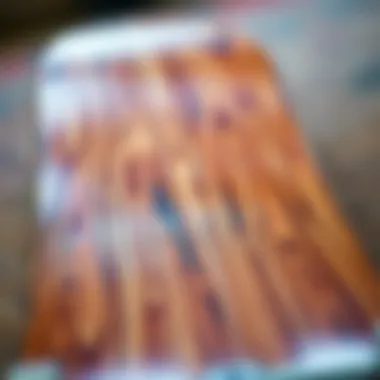
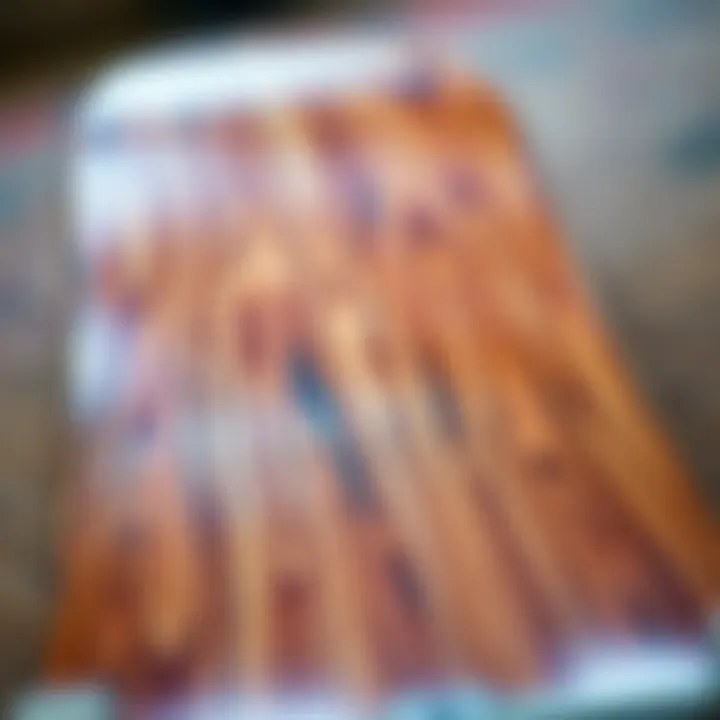
One of the standout characteristics of maple is its layering capability; multiple plies can be pressed together to create a robust structure. This aspect plays a vital role in elevating the board's lifespan. However, its commonality also poses a challenge: many skaters have a hard time distinguishing between low-quality and premium maple decks, making it essential to research brands carefully.
Bamboo
Bamboo is emerging as a different alternative that deserves consideration, especially in discussions about eco-friendliness. It is lightweight yet surprisingly strong, which appeals to riders who prioritize agility and maneuverability. The flexibility of bamboo can enhance performance in tricks like ollies or kickflips, as it offers a lively feel underfoot.
A unique feature of bamboo is its sustainability—it grows much faster than traditional hardwoods, making it a favorite among environmentally-conscious skaters. Nonetheless, bamboo's inherent flexibility might not suit everyone; some riders may prefer the stiffness that other woods offer for higher-impact tricks.
Plywood
Plywood finds its place as a balanced option in the realm of skateboard decks. Comprised of several thin layers of wood glued together, it offers a blend of strength and flexibility. The layering process helps mitigate the risk of warping, which can occur with some thicker solid woods.
The versatility of plywood makes it popular not only among budget-conscious riders but also among those exploring custom designs. However, the durability can vary significantly based on the quality of the ply used; poor-quality plywood could lead to a less-than-optimal skating experience, diminishing both performance and lifespan.
Alternative Materials
Plastic
Plastic skateboard decks have been a topic of discussion, especially in consideration of durability and maintenance. Unlike wooden decks, they do not absorb moisture, which reduces the risk of rotting or warping. Being highly resilient, these decks are ideal for skaters who frequent wet environments.
A notable advantage is their affordability—plastic boards can be much more accessible for beginners, allowing entry into the sport without a massive financial outlay. On the downside, they may lack the responsiveness and feel that skilled riders crave, making them less appealing for advanced techniques.
Carbon Fiber
Carbon fiber is the luxurious material in the skateboard realm, offering an exceptional strength-to-weight ratio and superb responsiveness. Its unique properties allow for sharp turns and precision, providing a premium riding experience that many enthusiasts cherish. Often, carbon fiber decks are designed for competition and extreme sports where performance levels are critical.
However, the main downside is the price point. High-quality carbon fiber boards can set skaters back considerably, which might deter casual riders. Furthermore, repairs due to damage can be tricky—once broken, these decks often cannot be repaired like traditional wood ones, making care essential.
Whether opting for wood or alternative materials, each has its unique advantages and characteristics. By understanding the range of options available, skaters can make well-informed decisions that suit their unique styles and preferences.
Construction Techniques
Construction techniques play a pivotal role in shaping the quality and performance of skateboard decks. The methods employed not only determine how a deck looks but also influence its structural integrity, weight, and overall ride experience. Understanding these techniques gives skateboarders and enthusiasts a clearer picture of what to expect from different decks. Let’s delve deeper into two main construction aspects: ply construction and molding processes.
Ply Construction
Ply construction is fundamental to creating a robust skateboard deck. This technique involves layering thin sheets of wood, typically maple, to form a finished board.
Number of Plies
The number of plies directly affects the skate deck's stiffness and durability. Commonly, decks feature between seven to nine plies. A seven-ply deck tends to be lighter, making it a popular choice for those who prefer street skating, where agility is key. Conversely, an eight or nine-ply deck is stiffer, providing stability for tricks and jumps, particularly suited for vert skaters.
The main characteristic of these varying ply numbers affects how the board responds during tricks. A thicker, more layered construction often translates to a more durable deck, capable of withstanding harsh impacts and everyday wear. However, these advantages may come at the cost of weight—sometimes heavier decks can feel sluggish to some riders.
In practical terms, a seven-ply skateboard deck might flex more than a nine-ply. This means if you’re looking for a deck that offers a sprightlier feel for a street setup, a seven-ply might be your best bet. However, for those attempting larger vert tricks, opting for the sturdier nine-ply can enhance performance significantly.
Layering Techniques
Layering techniques further refine how these plies work together. There are various approaches: some manufacturers use uniform layers, while others may vary the thickness of individual plies. This deliberate variation creates a unique flex pattern, impacting the board’s responsiveness.
For example, a technique that combines thicker inner plies with thinner outer plies can create a board that absorbs shock effectively while maintaining enough stiffness for pops during tricks. This method is increasingly seen as a best practice among high-end manufacturers.
Such layering not only contributes to the performance characteristics but also impacts aesthetics. It allows for more complex designs that skateboarders may appreciate. However, it’s crucial to weigh the benefits against potential drawbacks, like increased production costs.
Molding Processes
Molding processes are equally essential in deck construction, focusing on how the layers of material are shaped and bound together. This includes techniques like heat pressing and vacuum forming, each offering unique benefits.
Heat Pressing
Heat pressing is a traditional yet highly effective molding technique used in skateboard deck manufacturing. This process applies heat and pressure to bond the plies, ensuring they adhere tightly while also allowing the deck to take on its desired shape.
A notable characteristic of heat pressing is that it fosters consistent results, producing decks that maintain quality across batches. The durability often associated with decks made this way is a significant selling point. Furthermore, heat pressing allows for nuanced shapes and designs that can offer functionality in addition to visual appeal.
However, there is a caveat. The heat involved can impact the integrity of certain types of wood or adhesives, potentially leading to lower performance in decks if not executed correctly. It is vital for manufacturers to strike a balance, ensuring sufficient heat without compromising the material's properties.
Vacuum Forming
Vacuum forming, a more contemporary method, utilizes vacuum pressure to shape boards. This process allows manufacturers to create unique contours and designs that heat pressing sometimes cannot achieve. The key characteristic here is the precision it provides, resulting in sleek, aesthetically pleasing decks.
The uniqueness of vacuum forming lies in its capacity for customization—perfect for brands looking to stand out or create limited runs. While this method offers impressive design potential, it often requires more specialized equipment and can be pricier to produce, making it less common among budget brands.
Performance Characteristics
When discussing skateboard decks, performance characteristics play a pivotal role in shaping the riding experience. These attributes directly influence how a skateboard behaves under various conditions, thereby affecting both the rider's ability to perform tricks and the overall fun factor of skating. Central to these characteristics are weight, balance, flexibility, stiffness, and durability. Let’s take a closer look at these aspects, their importance, and how they influence the skateboard experience.
Weight and Balance
The weight of a skateboard deck can make or break a rider's performance. A lighter deck typically allows for easier tricks and quicker maneuverability, which can be a significant advantage during street skating or vert sessions.
In contrast, a heavier deck provides greater stability during high-speed rides and tricks, making it preferable for those who enjoy skating on ramps or doing grinding. When it comes to balance, a well-designed deck should evenly distribute weight, allowing for a stable ride. Factors that contribute to this stability include the shape of the deck and the placement of the trucks.
It’s important to note that personal preference plays a substantial role here. Riders often develop a comfort zone based on their style. If you're new to skating, it may be a good idea to experiment with various weights to find your ideal deck.
Flexibility and Stiffness
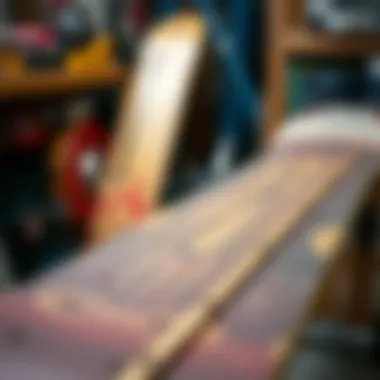
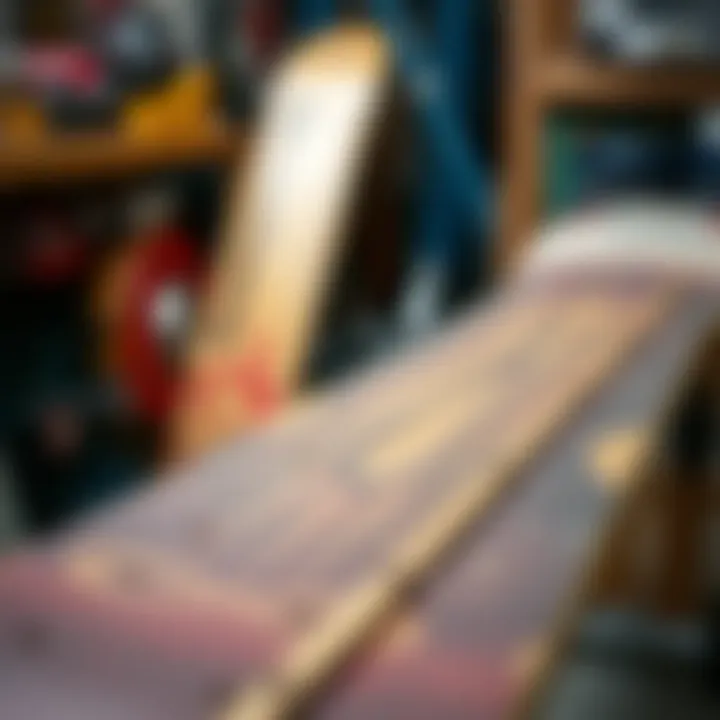
Flexibility and stiffness are two sides of the same coin and are another critical performance characteristic. Decks with more flexibility tend to absorb impacts better, which can enhance comfort during tricks. This is especially relevant for park skaters, where jumps and drops are common. A flexible board can provide a spring-like effect, offering a boost during tricks like ollies and kickflips.
On the flip side, a stiffer deck generally provides more control and responsiveness, which is vital for technical tricks and higher precision during skating. So, it boils down to a matter of riding style: those who frequently perform big-air tricks might lean towards a stiffer deck, while those who favor street tricks may opt for more flex.
Durability and Longevity
Finally, there is the matter of durability and longevity. Investing in a superior skateboard deck means considering how long it will last under the aggressive conditions of skating. Decks made from high-grade maple are renowned for their durability. They withstand not just basic wear and tear but also the rigors of skateboarding culture itself.
Regular maintenance, such as checking for cracks or warping, can prolong the life of any board. Riders who take this seriously often see their decks last much longer than average. Healthier decks mean fewer replacements, which can save some cash in the long run, enhancing the overall skater experience.
"A deck that performs well in all conditions can pave the way for a rider to develop their skills and take their skating to the next level."
Design Elements
Design elements of skateboard decks play a crucial role in defining not only the aesthetic appeal but also the functionality and overall performance of the deck. Understanding these elements empowers skaters, both seasoned and newbies, to make informed choices tailored to their specific needs. Key design traits, such as shape variations and graphic designs, are more than just trends; they reflect personal style and influence how a skateboard performs on the street or in a park.
Shape Variations
Concave
Concave shape is one of the most talked-about features in skateboard decks. This refers to the inward curve of the board from tail to nose. A significant aspect of concave is its ability to facilitate better control and ollie height. This shape allows skaters to tuck their feet in, providing an improved grip during tricks. Concave decks are a popular choice because they make performing flips and spins more manageable. When looking at a concave deck, one of its unique features is the depth of the curve, which can vastly influence the riding experience.
While concave designs present advantages such as increased maneuverability, they can sometimes limit the comfort level during regular cruising, particularly for beginners who may prefer a more stable platform.
Wider Boards
Wider boards, generally defined as those exceeding the standard width of about 8 inches, supply an ample surface area that many skaters find advantageous. The primary characteristic of wider boards is stability; they offer a more secure footing, especially useful for larger tricks or when landing jumps. Riders who focus on street skating or heavy tricks prefer this design much more for the extra room to balance.
However, a broader deck can limit navigation in tight spaces. It can be a double-edged sword; while it provides security, it may reduce agility.
Narrow Boards
On the flip side, narrow boards typically range from about 7.5 to 8 inches in width. The principal benefit of narrow boards is their light weight, making them easy to maneuver and flick during tricks, particularly in skate parks. These boards are a favorite among trick skaters who need quick foot movements for flip tricks and grinds.
Despite their advantages, narrow boards can present challenges in stability, especially for larger riders or when executing high-impact moves. If a skater is not comfortable with their foot positioning, they may struggle with balance, affecting their performance on a wide range of maneuvers.
Graphic Design Trends
Artistic Expression
Artistic expression through graphics is a significant component of skateboard culture. Designs can range from intricate art styles to minimalist logos, representing personal identity and communication of individual style. Graphics play a vital role, as they can not only stand out in a crowd but can also spark conversations within the community. The uniqueness of artwork can reflect social aspirations, music influences, or even political messages, thus offering a deeper meaning beyond just aesthetics.
However, artistic choices can sometimes overshadow functionality. A deck with amazing graphics may not always perform well if other aspects like construction are not up to par.
Brand Influences
Brand influences have a profound impact on deck design, with well-known companies bringing a host of specialized designs catered toward different skating styles. Brands often collaborate with artists or pro skaters, leading to limited edition runs that combine quality and a unique artistic vision. These collaborations can provide skaters with a sense of belonging to a larger community or culture.
While brand name can improve confidence in quality, it can also lead to inflated prices. Some may argue that a deck's performance should take precedence over its branding. The challenge for consumers lies in balancing personal preference with reliable performance and cost-effectiveness.
Understanding the design elements is not just about aesthetics; it’s also about how these features influence the way a skateboard operates and ultimately enhances or hinders a rider's experience.
In summary, the interplay between the shape variations and graphic designs leaves a lasting impression on both performance and culture. Skaters should be thoughtful about each design element, taking into account their personal style, riding abilities, and the trends they wish to embrace.
Selecting the Right Deck
Choosing the right skateboard deck is akin to picking out the right shoes before a long trek; it significantly impacts performance and enjoyment. Riders, whether they're novices learning the ropes or seasoned skaters perfecting their craft, must consider various variables to get the best match. Deck selection isn't just about aesthetics; it melds with an individual's unique style and riding preferences, providing the foundation upon which all skateboarding experiences are built. A well-chosen deck can enhance skills, aid in the development of techniques, and ultimately lead to greater satisfaction on the board.
Skill Level Considerations
When sifting through options, skill level is a crucial point of focus. A beginner skater might not require the features found in a high-end deck, while a pro will benefit from advanced specifications. Certainly, a lightweight deck might seem appealing to newcomers, but it could lack the sturdiness needed for tricks. Likewise, opting for an overly heavy deck can hinder a player's agility. Finding a deck suitable for one's skill level allows for a comfortable learning curve.
Riding Style Match
The riding style is just as vital when selecting a deck. Each skater has a flair, whether they zip in urban settings, conquer ramps, or pull off tricks in freestyle. Here’s how each style factors in:
Street Skating
Street skating is where creativity meets technical prowess on urban terrain. Skaters typically utilize obstacles like benches, curbs, and stairs to perform tricks. This style demands a deck that offers a good balance of strength and pop. Decks designed for street skating often feature a more pronounced concave for better grip and trick control. This characteristic makes it a popular choice for many riders who want to easily flip and shuffle their boards during maneuvers. Sometimes, though, the thinness of street decks may sacrifice durability when faced with rough surfaces.
Vert Skating
Vert skating throws individuals into the mix of ramps and half-pipes, where height and gravity play pivotal roles. Decks suited for vert skating are generally wider and longer, providing better stability during airborne tricks. The added width accommodates bolt patterns necessary for stronger trucks, which are imperative for handling the increased forces during tricks. However, the heavier build can be cumbersome for some; it's a tool made for the thrill-seeker who is prepared to optimize their skating experience. That stability comes at a cost of agility compared to lighter boards, making rider preference crucial.
Freestyle
Freestyle skating embraces a world without rules, allowing riders to express their unique style through tricks on the flat ground. This style often requires lighter decks with flexible structure, empowering skaters to perform pivots, spins, and even tricks like the "no comply". An ideal freestyle deck is generally shorter, offering a compact feel for signature moves. But with great flexibility comes a challenge, as these decks may not hold up well during heavy tricks. Thus, the skilled freestyler must strike a balance between lightness and durability, ensuring their board aligns with their individual flair.
Trends in Skateboard Decks
Understanding current trends in skateboard decks is crucial for both seasoned skaters and newcomers alike. As the skateboarding culture evolves, so do the materials, designs, and preferences within the skateboard community. This section offers a closer look at two significant trends: eco-friendly materials and custom decks. These elements not only shape the functionality and aesthetic of the decks but also reflect broader environmental and expressive shifts within the sport.
Eco-Friendly Materials


As environmental awareness grows, many skateboard brands are stepping up to the plate by incorporating eco-friendly materials into their products. Riders today are more conscious of their impact on the planet. Skateboarders are not just aiming for a slick ride; they want their choices to resonate with sustainability.
Some popular materials are:
- Bamboo: A fast-growing plant that requires minimal resources to cultivate, bamboo is becoming quite the favorite. It’s lightweight yet surprisingly strong. Many riders swear that bamboo boards flex beautifully without compromising durability.
- Recycled Wood: With a steady influx of recycled wood inputs, some brands have begun to churn out decks crafted solely from repurposed timber. This approach not only optimizes waste but also adds a unique character to each board.
- Biodegradable Plastics: Innovators have been experimenting with biodegradable plastics for skateboards. While traditional plastics can linger for hundreds of years in landfills, biodegradable options promise to break down more naturally when disposed of.
These materials are not merely a trend; they signify a shift in the market. As awareness grows, customers are increasingly likely to support brands that prioritize sustainable practices. High-quality materials also foster longevity, making it easier for both the environment and the rider's wallet.
"The only man I envy is the man I could have been." - Aristotle
Custom Decks
Customization in skateboard decks is soaring, reflecting the growing desire among riders for individual expression. Skaters want their boards to stand out from the crowd, and many brands are offering trendy customization options. This trend goes beyond mere graphics; it's about making a deck that feels personal and authentic.
Some popular avenues for customization include:
- Graphics: Artists and designers are collaborating with skateboard brands to create limited-edition artworks, often leaving a strong impression on the culture. Riders might choose tribes of graphics or even family portraits—whatever feels right to them.
- Shape and Size: Custom shapes and sizes have become increasingly accessible. Riders can choose wider boards for more stability or narrower boards for tricks. This tailored approach helps skaters both express themselves and optimize performance based on their riding style.
- Color Schemes: From vibrant color splashes to muted tones, the options for finishes and color combinations are nearly endless. A skateboard no longer just serves a functional purpose; it becomes a canvas for self-expression.
Customization isn’t just about looks; it’s about creating a bond. Riders forge connections with their decks, making the entire experience—whether gliding along a half-pipe or doing tricks on the street—even more fulfilling.
The trends of eco-friendly materials and custom decks exemplify how the skateboard landscape is continually shifting. These developments reflect not only changing consumer preferences but also the broader cultural ethos surrounding skateboarding. Becoming aware of these trends can help riders make informed decisions, pushing them toward boards that mirror their values and personal style.
Caring for Your Skateboard Deck
Proper care for a skateboard deck is essential for maintaining performance and prolonging its lifespan. Regardless of whether you're a seasoned skater or just starting out, understanding how to care for your deck can help you avoid unnecessary expenses and ensure a smoother ride. A neglected deck can lead to decreased performance, safety concerns, and costly replacements. Taking the time to care for your skateboard is time well spent.
Routine Maintenance
Regular maintenance is the cornerstone of skateboarding care. Here are some essential practices to keep in mind:
- Inspect the Deck Regularly: Make it a habit to check for any cracks or warping after each session. If you spot any signs of damage, it may be time for a replacement.
- Clean the Surface: Dirt and grime can easily build up on the grip tape, affecting your traction. Use a brush to scrub the grip tape gently. You can also use a cleaner specifically designed for grip tape for deeper cleaning.
- Check the Trucks and Wheels: Regularly examine the trucks for tightness and adjust if necessary. Also, inspect the wheels for flat spots or wear.
- Store Properly: When not in use, lean your skateboard against a wall rather than leaving it on the ground. Avoid placing heavy objects on the deck, as it can lead to warping.
- Keep Away from Humidity: Storing your skateboard in a damp area exposes the wood to moisture, ultimately damaging it. Opt for a dry area to avoid issues with rot or warping.
Benefits of Routine Maintenance
Regular upkeep not only preserves the quality of your skateboard but enhances your overall experience. A well-maintained board handles better, allowing you to skate safely and effectively.
Damage Repair Techniques
Even with careful handling, dings and scratches are inevitable. Knowing basic repair techniques can save your deck:
- Minor Scratches: If your deck has minor surface scratches, using sandpaper can help smooth them out. Start with a fine grit and gently work on the surface.
- Cracks: For deeper cracks, strengthening them with wood glue may suffice. Apply a thin layer of glue into the crack, wipe away excess, and clamp it until the glue dries.
- Reapplying Grip Tape: If your grip tape is worn or rips, replacing it is crucial. Peel off the old tape, clean the surface underneath, and apply the new tape while smoothing out any air bubbles.
- Professional Repairs: Significant damage, such as large cracks or complete breaks, might require professional repair services. Avoid risking injury by attempting to fix severely compromised decks.
"Caring for your skateboard deck is much like tending to a garden. A little maintenance goes a long way in ensuring it thrives!"
Incorporating routine maintenance and knowing how to address potential damage can greatly affect your deck's performance and lifespan. Thus, investing time into what may seem like mundane tasks can save you not only money in the long run but also make your skating experience far more enjoyable.
Market Comparison of Brands
When diving into the realm of superior skateboard decks, a keen assessment of the various brands available on the market quickly becomes pivotal. Understanding the nuances of each brand not only helps in making an informed decision but also highlights the unique attributes that differentiate them. In a competitive landscape, brands invest in innovation, aiming to capture the attention of passionate skateboarders and professionals alike. Comparing various brands aids in recognizing which attributes truly matter to specific riding styles and conditions.
Moreover, with the growing variety of choices, evaluating these brands in terms of quality, reputation, and performance helps to demystify the seemingly overwhelming options. When skimming through product reviews or scouring skateboarding forums, the emphasis often shifts from personal preference to brand reliability. In this section, we’ll delve deeper into popular brands and scrutinize their characteristics and offerings, followed by a prudent assessment of price points.
Popular Brands and Attributes
- Element Skateboards
Known for its commitment to sustainability, Element uses eco-friendly materials in its decks. Their designs often feature vibrant graphics inspired by nature. Their specific combination of maple and bamboo creates a balanced deck suitable for both street and vert skating. - Plan B Skateboards
This brand has gained a loyal following for its high-quality pop and sturdiness. Their decks are engineered with multiple layers that enhance durability while providing excellent responsiveness. Plan B has also made a name for itself through collaborations with professional skateboarders. - Almost Skateboards
Almost is recognized for its innovative technologies, like the Resin-7 epoxy glue, that bond the layers of wood. This process prevents delamination, making their decks one of the toughest on the market. They combine practical designs with artistic custom graphics that appeal to various riders. - Santa Cruz Skateboards
Established in the 1970s, Santa Cruz has a long-standing tradition in skateboard culture. Their decks carry legendary graphics, and they boast a unique flexibility that sets them apart from other brands. Combined with their strong wood composition, Santa Cruz decks are a classic choice.
By analyzing these brands and understanding their unique attributes, skateboarders can align their choices with personal skating styles and preferences, ensuring they select a deck that fits their needs.
Price Point Assessment
Assessing price points within the skateboard market is akin to comparing apples and oranges - much depends on the specific needs and experience levels of the rider. Generally, higher-quality skateboard decks made from premium materials often command a steeper price. However, it is important to discern when a price reflects genuinely enhanced features versus simple brand prestige.
- Budget-Friendly Options
Entry-level decks can range from $30 to $60, which typically serve beginners or casual skaters. Brands such as Santa Cruz might offer starter models that maintain decent durability. These decks can withstand falls and are perfect for learning essential tricks. - Mid-Range Decks
A price range from $60 to $90 tends to be where many mid-tier brands, like Almost or Element, fall. These decks often strike a balance between durability and performance, ideal for those advancing in skill level without breaking the bank. - High-End Choices
Premium decks often cost over $90, with some specialized models reaching upwards of $150. Plan B and Element’s superior offerings might be found in this category, appealing to serious skateboarders who prioritize performance and longevity in their deck choices.
In essence, knowing the landscape of skateboard brands and price points is invaluable. It provides clarity, ensuring that riders feel confident in their investment, whether they're novices or seasoned pros. Understanding the interplay between these factors ultimately contributes to effectively shopping for a skateboard deck that suits individual needs and preferences.
Culmination: The Future of Skateboard Decks
As we stand on the cusp of new developments in skateboarding, it’s crucial to recognize how both technology and culture shape the future of skateboard decks. In this final section, we’ll unravel the broader implications of these changes while reflecting on how they impact riders at all levels.
Emerging Technologies
Emerging technologies are reshaping what we know about skateboard decks. Advancements in materials like carbon fiber and composite structures are not just fads; they represent an exciting leap towards enhanced performance and durability. For instance, carbon fiber decks provide unmatched strength while remaining lightweight, making tricks easier and more efficient. Interestingly, companies are experimenting with smart technologies that can measure performance metrics such as speed, balance, and even rotation angles. These innovations can provide valuable insights for skaters seeking to improve their skills or for brands aiming to attract tech-savvy consumers.
Another notable trend is the integration of 3D printing in skateboard manufacturing. This technique allows for customization like never before, letting riders design decks tailored to their own preferences, aesthetics, and riding style. Imagine creating a unique deck that fits your foot exactly or features art only you can appreciate.
- Strengths of Emerging Technologies:
- Lightweight yet strong materials
- Customization possibilities
- Performance tracking capabilities
The Evolving Skateboard Culture
Skateboarding is more than just a sport; it’s a culture that continues to evolve. The influences of social media, competitions, and global events have contributed to the resurgence of skateboarding trends. Today, skateboarding represents a form of expression and freedom that resonates with diverse communities worldwide. Riders are not just athletes; they are artists, innovators, and community leaders.
Additionally, the rise of eco-consciousness within skateboard culture aligns with the global push toward sustainability. Many brands are prioritizing eco-friendly materials and sustainable practices in their decks. This can involve using reclaimed wood or biodegradable resins in the manufacturing process.
- Key Cultural Shifts in Skateboarding:
- Emphasis on community and inclusivity
- Strong environmental awareness
- Embracing digital platforms for creative expression
To encapsulate it all, the future of skateboard decks is a tapestry woven from technological innovation and cultural richness. It’s a stage where performance meets personal expression, and as these elements cultivate, they create pathways for new talent and ideas. Understanding this interplay is essential for anyone looking to thrive in the skateboard industry, whether as a rider, brand, or enthusiast.
"The only limits that exist are the limits we place on ourselves.”
As skateboarders venture into this new era, they will find opportunities to redefine what is possible. Whether shaping the decks of tomorrow or revolutionizing riding styles, skaters will play a pivotal role in the ongoing evolution of skateboard culture.







